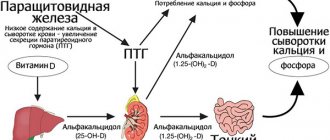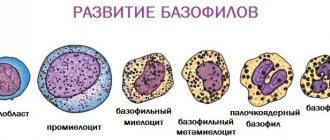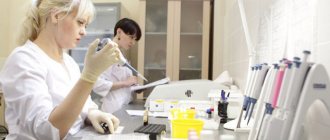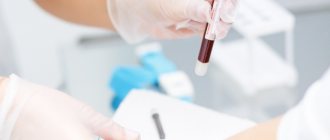The level of testosterone in women varies depending on many factors: age, time of day, phase of the menstrual cycle, etc. Deviation upward or downward may indicate pathology, but can also be associated with a sedentary lifestyle, psycho-emotional overload, poor nutrition, chronic stress . To identify the cause of the disorder and correct it, you should consult a doctor.
Testosterone (from the Latin testis - male testicle, male strength and stereos - hard) is a male sex hormone that ensures normal sexual development in men and women, regulates puberty and sexual function, and influences the development of secondary sexual characteristics. Its biosynthesis occurs with the participation of gonadotropic hormones of the pituitary gland - follicle-stimulating and luteinizing.
Testosterone in women is produced by the adrenal glands and ovaries.
The precursor to testosterone is cholesterol, which enters the hormone-synthesizing cells of the glands as part of lipoproteins. Testosterone biosynthesis begins with the cleavage of the cholesterol side chain and occurs through a series of sequential enzymatic reactions in which tissue enzymes participate. During biosynthesis, testosterone completely loses its side chain and is transported into the bloodstream.
Excess testosterone is caused by poor diet, obesity, and taking certain hormonal medications.
Circulating in the bloodstream, the main part (40–60% of total testosterone) combines with sex hormone-binding globulin, turning into a metabolically inactive form. The remainder of circulating testosterone is weakly bound to albumin, and only about 1–2% of total testosterone remains in free form. Free testosterone and testosterone bound to albumin are available to tissues and easily penetrate target cells. During the process of metabolic activation, testosterone is converted into a more active form - dihydrotestosterone, a small part is transformed into estradiol. Testosterone inactivation occurs in the liver.
What is testosterone responsible for in the female body?
In women, under the control of the pituitary gland, testosterone is synthesized in two main organs: the adrenal glands and the ovaries. This hormone is produced in small proportions by the adrenal glands and supplements the overall level. The bulk of testosterone is produced by the ovaries and released into the blood.
Once in the blood, testosterone performs many functions:
- it affects metabolism and controls the amount of fat deposited;
- the hormone helps build muscle mass;
- affects the activity of the sebaceous glands;
- promotes proper growth and formation of mammary glands;
- regulates the level of a woman’s sexual activity (with a large amount of testosterone, a woman is hypersexual, and with a low level, on the contrary, she does not feel the need for sex);
- testosterone, like any other sex hormone, affects psychological well-being in adulthood, helping to remain feminine in any situation. To feel fragile, desired and in demand. An increase in normal levels of the hormone in the blood increases a woman's activity, making her aggressive and exhibiting unhealthy control over people and situations. Too low a hormone content, on the contrary, causes passive behavior, apathy towards everything and excessive calmness.
- Testosterone in women (normal if it is contained in a small volume in the blood) is actively involved in the absorption of a number of substances, including those responsible for the normal formation of bone tissue.
- It regulates the degree of attractiveness to the opposite sex.
- Testosterone affects the functioning of the genital organs in women. It promotes the correct and timely production of eggs and the corpus luteum.
- This sex hormone also normalizes the functioning of all internal organs, which increases tone and improves mood. But such an effect occurs only when there is a sufficient level of the hormone in the blood.
Testosterone in women: its features and functions
What is testosterone? This is a biologically active substance produced by the ovaries and adrenal glands. It is secreted by the female genital organs with the help of pituitary hormones.
In women, testosterone is responsible for the intimate sphere: libido, vaginal lubrication. The functions of the hormone also include:
- Regulation of the activity of the sebaceous glands.
- Monitoring the functioning of the central nervous system.
- Responsibility for the growth of secondary sexual characteristics (mammary glands).
- Accumulation of fat layer. The process itself is a protection against stress.
- Muscle development as a guarantee of a woman’s physical activity.
Norm of testosterone in the blood of women by age
Depending on the development of the female body, growth and condition, the amount of testosterone in the blood changes as different organs and systems are connected to the process. So at a young age, the hormone is produced only by the adrenal glands. After reaching puberty, testosterone begins to be synthesized in the ovaries.
In pregnant women, testosterone is actively produced by the placenta for the normal formation of the fetus. In older women during menopause, the amount of testosterone in the blood increases. And then gradually decreases as reproductive capacity disappears.
Testosterone in women (its normal amount is present in the blood starting from birth) consists of a biologically active fraction (no more than 2%) and 98% of the hormone itself, bound by individual proteins. The hormone itself is measured in nmol/l, and its amount depends on the woman’s age and health status.
| Girls under one year old | Girls from 1 to 6 years old | Age from 6 to 11 years | Age from 11 to 15 years | Age from 15 to 18 years | Reproductive age from 18 before 50 years | During pregnancy | The period after menopause (from 50-55 years) | |
| Blood hormone level, nmol/l | 0-2,31 | 0-1,22 | 0,49-1,82 | 0,84-4,46 | 1,36-4,73 | 0.31- 3,78 | The norm increases up to 3-4 times | 0,4-4,51 |
Testosterone levels in a healthy body tend to fall and show the lower levels of normal. From 30 to 50 years, the concentration of the sex hormone can vary greatly in values.
For example, it increases during the period of ovulation in a woman. The worst effect on health is increased hormonal levels, which can cause various diseases and even cause death. Thus, a hormone level of 15 nmol/l poses a threat to the lives of elderly women.
Free testosterone
The concentration of free TC in the period from 0 to 9 years is 1.7 pg/l. By the way, the same number of picograms per liter of blood is found in boys during this prepubertal period.
During puberty, free testosterone increases to 4.1 pg/l and remains the same until menopause. During menopause, its amount drops again to 1.7 pg/l.
During pregnancy and ovulation, the androgen level can increase up to 4 times. In the second phase of the cycle, its indicator will also remain elevated.
In relation to the time period, the amount of biologically active substances also fluctuates: in the morning the indicator will be the highest, and in the evening it will decrease.
A decrease in the level of free hormone entails pathology in the normal process of burning fat and forming muscle mass. The cause may be diet, poor lifestyle, smoking, obesity, stress, menopause, or chronic disease.
Signs of a reduced level of free TC may be:
- Sweating
- Fatigue
- Drowsiness
- Oily skin
- Depression
- Weak sexual desire
Causes of deviations in hormone levels from normal
Producing the required amount of testosterone is very important for the female body. But a number of factors can significantly affect its synthesis.
First of all, these are natural reasons, such as:
- the period of pregnancy during which testosterone production increases 4 times. This is due to additional active production of the hormone by the placenta. Moreover, if a boy is to be born;
- the period of menopause, when, for natural reasons, the ovaries stop actively working and hormone production is greatly reduced;
Testosterone levels decrease in women during menopause
- Testosterone also increases during the period of ovulation, which increases female attractiveness naturally;
- hereditary predisposition to increased testosterone levels.
Changes in hormone levels are greatly influenced by lifestyle and certain habits:
- A strict diet with a limited amount of quickly digestible carbohydrates significantly reduces testosterone levels;
- smoking and alcohol contribute to an uncontrolled increase or decrease in hormone production;
- vitamin deficiency (lack of vitamins) often causes disorders associated with insufficient hormone production;
- a sedentary standard of living and lack of systematic sports training affects changes in hormonal balance, as well as obesity;
- long abstinence or lack of full sexual life contribute to an increase in hormone levels;
- Failure to produce hormones in normal quantities occurs after prolonged use of medications. In particular, the amount of testosterone is strongly influenced by oral contraceptives containing estrogen-progestogen.
Often changes in testosterone levels are associated with diseases.
These include:
- diseases of the uterus (endometriosis);
- adrenal insufficiency;
- pituitary adenoma;
- the postoperative period during removal of the ovaries, when testosterone levels also decrease and in this case hormonal therapy is prescribed;
- dysfunction or hyperfunction of the adrenal cortex, in which the release of the hormone occurs uncontrollably;
- breast cancer, cysts and ovarian tumors.
Reasons for the increase in concentration
In women, the most common predisposing factors include, first of all, an incorrectly formulated diet. The problem of excessive levels of the hormone in the blood is most often faced by those ladies who adhere to strict diets. Other reasons include hereditary predisposition, prolonged use of a number of medications that affect the state of hormonal levels in general and the content of individual hormones in particular, as well as high physical activity.
Testosterone may also increase if tumors develop. Temporary causes that do not have significant clinical significance include, as mentioned above, pregnancy.
Signs of increased and decreased testosterone
An increase and a strong decrease in the amount of testosterone can be easily determined in a woman by the signs that accompany these changes.
So, with a reduced level of the hormone, it is typical:
- excessive calmness and lethargy, apathy towards everything;
- absence or significant decrease in sexual desire;
- the appearance of unpleasant sensations during sexual intercourse, lack of orgasm;
- bad mood, increased absent-mindedness, insomnia;
- the skin becomes thinner, becomes dry and sensitive, all small wounds and cuts heal poorly, the hairline also decreases;
- fatigue increases and endurance sharply decreases, muscle weakness appears;
- low testosterone levels in a number of other factors contribute to the appearance of osteoporosis, diabetes, obesity (especially in the shoulders, buttocks and thighs).
A large amount of testosterone is present in a woman’s blood for 6 or more months. has an effect on the body, causing:
- increased hair growth on the face, stomach, arms and legs, their darkening. Hair becomes thicker and coarser. Hair may appear on the mammary glands and neck. On the opposite head, hair may become brittle and begin to fall out;
- character changes. Tough, aggressive traits appear, hot temper and rudeness towards everyone;
- a sharp increase in sexual desire;
- menstrual irregularities (menstruation becomes more infrequent with scanty discharge);
- infertility or problems with bearing a fetus;
- causeless uterine bleeding;
- the appearance of male-type obesity (in the abdominal area) or sudden weight loss, the appearance of anorexia nervosa.
With prolonged low or high concentrations of the hormone in the blood, chronic disturbances in the functioning of internal organs are observed, which can lead to serious diseases, including oncology. Therefore, it is so important to promptly diagnose and consult a doctor if the first signs are present.
Reasons for deviations and why they are dangerous
The consequences of changes in testosterone levels in women can be different depending on how much the indicator changes and in which direction - more or less.
Increased level
If the results showed an increase in testosterone levels, the reasons may be:
- Hirsutism is a genetic disease in which testosterone is produced in increased quantities. A sign of hirsutism in women is abundant hair on the body.
- Polycystic ovary syndrome is an endocrine pathology characterized by intense production of male hormones in the female body.
- Adrenal hyperplasia is a congenital pathology in which the body lacks enzymes that regulate the production of reproductive hormones.
An increase in the concentration of the hormone is observed in diabetes mellitus, obesity, and dysfunction of the hypothalamus.
If the indicators are exceeded, the following symptoms occur:
- hair growth in places atypical for a woman: on the face, chest;
- failure of the menstrual cycle - periods are irregular or absent for a long time, the volume of menstrual flow may increase or decrease;
- inability to conceive a child or bear a fetus;
- gaining excess weight up to obesity;
- profuse sweating;
- low voice;
- hair loss on the head;
- the appearance of stretch marks;
- presence of oily seborrhea;
- arterial type hypertension;
- change in psycho-emotional state: aggressiveness, increased temper;
- formation of a figure according to the male type;
- increased sexual desire.
Important information: Progesterone levels during early pregnancy (table)
Lifestyle also affects the production of hormonal substances. The male hormone is elevated in women who smoke and regularly drink alcohol, as well as in the absence of regular sex life.
Low level
A decrease in the amount of testosterone is observed in the following situations:
- The natural process of aging of the body with the onset of menopause. The functioning of the ovaries is inhibited, which are no longer able to produce the required amount of the hormone.
- Long-term use of hormonal drugs, in particular oral contraceptives containing estrogen.
- Diseases of the ovaries and adrenal glands, which are the main suppliers of androgen.
Signs of low testosterone:
- Lethargy, apathy, excessive equanimity and calmness.
- Decreased or complete absence of libido.
- Sexual contact does not bring pleasure due to the lack of orgasm; during sex, unpleasant physical sensations may occur.
- Changes in mood - a woman is tormented by absent-mindedness, insomnia, and her psycho-emotional state is always depressed.
- Decreased muscle mass.
- Development of chronic fatigue syndrome.
- Decreased mental activity, forgetfulness, impaired concentration and attention.
- The skin is dry, flaky, and becomes thin. Even the smallest wounds heal slowly and poorly.
- Depressive states.
- Lack of natural vaginal lubrication.
- Increased drowsiness, feeling of fatigue that occurs even after minor physical activity.
Against the background of low levels of the hormone, if the situation is not corrected for a long time, diabetes, osteoporosis may develop, and excess fat begins to be deposited on the hips, buttocks and shoulders.
Diagnostics
Testosterone in women (the norm of its content in the blood can vary depending on the life stage) is established today simply - you need to donate blood for a detailed analysis from a vein.
Before donating blood for analysis, you need to prepare:
- stop taking hormonal medications 3-4 days before;
- in 18 hours Before the analysis, you are not allowed to smoke or drink alcohol;
- physical activity and sexual intercourse should be limited during the day;
- on the eve of donating blood after 8 pm and the next morning you cannot eat anything, because the analysis is carried out on an empty stomach;
- It is better for a woman to conduct such a study on days 6-7 of the menstrual cycle to obtain accurate indicators.
Within a day you will be able to find out the answer. If the result is lower or higher than normal, it will be necessary to undergo an appropriate examination to determine the causes associated with changes in hormonal levels.
In rare cases, the causes of changes in hormone levels may be natural, but this does not exclude congenital and chronic diseases that require professional treatment.
Diagnosis of changes in hormonal balance is carried out in the following areas:
- an ultrasound scan of the uterus and ovaries is performed;
- ultrasound of the mammary glands;
- ultrasound of the adrenal glands and other internal organs;
- a blood test is taken to determine the concentration of adrenocorticotropic and growth hormone, as well as prolactin and estrogen;
- conduct a study of general hormonal levels;
- MRI of the brain (pituitary gland);
- blood sugar test;
- blood test for cholesterol.
All types of analyzes and research must be carried out in strict accordance with the requirements. So, a cholesterol test is carried out on an empty stomach, and you cannot eat after 6 o’clock the previous evening. Otherwise, the result will not correspond to real indicators, which will affect the prescribed treatment.
Only after a comprehensive study can conclusions be drawn and measures taken to reduce or increase testosterone levels.
On what day of the cycle should I take the test?
The optimal time for diagnosis depends on the length of the woman's menstrual cycle. The “correct” day will be calculated by the gynecologist. With a standard 28-day cycle, the test is prescribed on days 2-5 of the cycle. If the cycle is 32 days, then you need to donate blood on days 5-7. If the menstrual cycle is short (21 days), the doctor will prescribe a test on the 2-3rd day of menstruation. If pregnancy occurs, the day of blood sampling does not matter.
Methods to increase testosterone
Low testosterone levels in the blood after a full examination must be treated with medication. The medications and dosage are determined by the attending physician. However, even before you start taking medications, you can influence the level of the hormone in the blood by revising your lifestyle.
- Eliminate causes that may provoke a decrease in hormonal levels. Give up bad habits and go in for sports.
- You should streamline your sex life. Start looking for a permanent partner or a way to eliminate abstinence.
- The level of sex hormone production is affected by stress, so all situations associated with stress on the nervous system should be excluded. This may require changing your job or field of activity, moving or switching to public transport, if necessary.
- The body often returns to normal on its own and begins to intensively produce testosterone when receiving bright positive emotions and constantly being in a good mood. This can be facilitated by a long vacation, including abroad, going to the cinema or purchasing an interesting book. Expanding your social circle and social activities improves your mood.
- As a basis for normalizing the functioning of internal organs, a vitamin course is recommended. In this case, you should approach this process seriously, together with your doctor, individually select professional vitamin preparations and consult about the course of their administration.
- You will also have to reconsider your diet in order to achieve a balanced and nutritious diet that will affect testosterone production.
What should a woman do when testosterone is elevated? Options for solving the problem
You can return testosterone levels to normal levels at home with the help of diet and exercise.
A woman needs to reconsider her diet so that it contains foods rich in potassium, phosphorus, calcium, and vitamins (C, E, B, D). Accordingly, you need to increase consumption:
- Lean meat.
- Fish and seafood.
- Dairy products.
- Fresh vegetables and herbs.
Exercising can also normalize testosterone levels. A woman is recommended to do yoga, Pilates, and aerobics. Moderate physical activity helps restore healthy hormonal levels without resorting to medications.
If nutritional correction and exercise fail to reduce testosterone production, then specialists prescribe hormonal medications. Additionally, traditional medicine is used. Teas and decoctions based on medicinal herbs help with high testosterone. The choice of plants for treatment is large: evening primrose, licorice, vitex.
Article on the topic:
The hormone prolactin. Normal in the female body depending on age
Food
To increase the production of the hormone in the blood, you need to eat less white bread, rich pastries and a lot of spices. It is worth saturating your food with healthy foods that will help restore hormonal balance.
- nuts contain vitamins and minerals that are necessary for the synthesis of testosterone;
- Seafoods are rich in zinc and omega-3, omega-6 acids. It is zinc that is the basis for the hormone, therefore, coupled with the necessary microelements, testosterone production occurs at an accelerated pace;
- cereals (wheat) are also rich in zinc and other vitamins;
- legumes, whether fresh, frozen or canned, contain the right combination of protein and fiber to normalize metabolic processes;
- sweet fruits, which are a storehouse of vitamins and nutrients (bananas, pineapples, melons), should be included more often in the diet.
Recommendations for normalizing hormonal balance
Of course, in some difficult situations you cannot do without hormone therapy, but if the cause of the imbalance is poor nutrition, strict diets, or alcohol consumption, then by adjusting your diet to include useful substances, everything can fall into place.
So, what should you eat:
- Zinc-containing products (sea fish, shrimp, nuts, domestic chicken).
- More amino acids! They are found in sunflower oil, olives, nuts, seafood, and seeds.
- Less fatty foods.
- Products of natural origin, that is, without harmful pesticides and genetically modified organisms.
If adjusting your daily diet does not bring effective results and your doctor prescribes hormonal medications, ask him to opt for natural-based hormones.
In order to avoid the negative impact of the developing disease, experts recommend that all women visit an endocrinologist and gynecologist annually. If you have a problem with weight, you can also consult a nutritionist.
Timely delivery of tests that determine the level of the hormone in the blood is important when planning pregnancy and bearing a child.
In the case of fairly pronounced manifestations of symptoms that interfere with the normal functioning of the body, you should contact a specialist.
Taking hormonal medications on your own is highly discouraged. Negative consequences may become irreversible.
This video will tell you about hormonal imbalance in women:
14 Sep 2020 Yuki 684
Share this post
We recommend reading along with this article
- About the normal level of the hormone LH
- Determining the probable day of ovulation with a 28-day cycle and the day...
- Let's find out what the progesterone rate is on day 21 of the cycle
- When can a woman become pregnant and is it possible to count the days in...
- Norm of prolactin in women and reasons for deviations from the norm
- Why does postpartum depression develop and how does it manifest?
- What to do if testosterone is elevated in women: doctors’ recommendations
- What does Dr. Komarovsky say about a general blood test in children?
- Norms for biochemical blood tests: how to decipher the result
Pharmacy drugs
In women, a number of pharmaceutical drugs help normalize testosterone levels and increase its concentration to the desired level. However, they must be prescribed by a doctor in order to select the required dosage in accordance with the test results. Self-administration of such drugs can significantly increase the level of the hormone and cause an imbalance in the body.
With the necessary degree of attention, the following drugs are used:
- methyltestosterone;
- non-local
This is done systemically until the desired effect is achieved, then the medication is stopped.
Level determination
The difference between the hormone total and free testosterone in women is relatively clear. You should also understand that to determine the percentage of all its indicators in the body, it will be enough to go to the nearest clinic and take the necessary test.
An analysis for free testosterone in women can be prescribed equally by both an endocrinologist and a gynecologist. If the patient does not know who to contact, then you can make an appointment with a therapist, and he will refer you to a specialist. The normal free testosterone index in women is established by medical standards and ranges from 0.31 to 3.78 nmol/l.
These values are typical for representatives of the fair sex who are of reproductive age, do not take oral contraceptives, and are not carrying a child, and are also tested on the 7-10th day of the cycle. In extremely rare cases, an enzyme immunoassay and blood sampling for it are prescribed on days 4-5 of the cycle.
The free testosterone index in women should be 12 times lower than in men. To get correct results, you must stop eating 10 hours before blood sampling, smoking and drinking alcohol are prohibited, only clean water is allowed. You should refrain from physical activity and stress for about 24 hours.
The leading specialist will tell you which testosterone (total or free) to give to a woman, after collecting an anamnesis and a preliminary examination of the patient.
Folk remedies
There are also folk remedies for increasing hormonal levels:
- So 100 grams of pollen should be mixed with half a can of condensed milk.
- The mixture should be kept in the refrigerator for 2 weeks, and then drunk 1 tbsp. in the morning 30 minutes. before meals.
- You should start taking it with 1 tsp, gradually increasing the dose to the desired level.
It is also recommended to take decoctions of ginseng, rose hips and rowan to increase testosterone levels.
How to normalize testosterone
A woman can adjust the concentration of testosterone in the blood by following a diet, taking medications and using traditional medicine methods.
Products
To increase testosterone, you need to introduce the following foods into your diet:
- Nuts - they contain mineral elements and vitamins that activate the process of producing hormonal compounds.
- Seafood is enriched with zinc, without which testosterone production is impossible.
- Wheat - contains vitamins and zinc.
- Legumes contain fiber and protein - elements that help normalize metabolic processes.
- Fruits: bananas, melons, pineapples - they contain nutrients and vitamins that support the smooth functioning of the hormonal system.
To reduce the hormone content in the female body, it is recommended to regularly consume:
- Honey, candied fruits, jam - vitamins and enzymes in their composition promote the production of estrogen, suppressing testosterone.
- Dried fruits reduce the amount of the hormone due to their vitamin and mineral composition.
- Oats - slows down the process of testosterone synthesis, helps convert it into the female hormone. Oats must be boiled in water and only after cooking add milk, sugar or honey.
Important information: Table of hormone levels in women by age
In order for testosterone to be normal, you need to gradually change your diet by introducing new foods. A sudden change in the usual menu can lead to negative consequences.
Folk remedies
During the period of taking medications and following a diet, it is recommended to use traditional medicine methods to normalize testosterone.
Recipe for increasing hormones:
- Mix 100 g of pollen with ½ can of condensed milk.
- Mix the ingredients and leave to infuse for 14 days in the refrigerator.
- At the beginning of the course, take 1 tsp. Every day the dosage should be increased little by little until it reaches 1 tbsp. l. The product should be used in the morning 30 minutes before breakfast.
Additionally, it is recommended to take decoctions based on rose hips, ginseng, and rowan. To prepare them, you need 1 tsp. pour the selected ingredient into a glass of water, leave for 30 minutes, strain. You can use decoctions instead of tea.
To reduce the hormone, you need to use peppermint. It can be brewed as tea or added as a spice to prepared dishes. In addition, decoctions based on angelica, red clover, and licorice root reduce the production of the hormone. They are prepared according to the standard recipe: 1 tsp. The selected herb is steamed with boiling water (250 ml), left to brew. Drink ¼ glass in the morning.
Traditional medicine methods should act only as an auxiliary element of complex therapy. The main treatment is with medications.
Medicines
For women, contraceptive drugs are prescribed to lower testosterone:
- Regulon;
- Spironolactone;
- Goserelin;
- Leuprolide;
- Abarelix.
Proper use of medications helps to normalize even the highest level of the hormone, reducing it to 2.34 nmol. The disadvantage of contraceptives is their strong influence on the hormonal system. Medicines are used only in case of severe deviation from the norm.
Medicines that can increase testosterone levels and are taken until the hormonal balance is completely restored:
- Nemestran;
- Methyltestosterone.
In addition to taking medications, diet and using traditional medicine to normalize hormonal levels, it is necessary to change your lifestyle. Basic measures: maintaining a proper daily routine with proper rest and sleep, a balanced diet, mandatory cessation of bad habits (smoking, drinking alcoholic beverages).
Methods for lowering testosterone
Elevated testosterone levels are much more dangerous, therefore, on the recommendation of a doctor, treatment of hormonal imbalance with medications should be started immediately:
- Additionally, it is necessary to eliminate bad habits (cigarettes, alcohol). Systematic exercise with increased loads is recommended, at least 3 times a week.
- Normalization of sexual life and psychological state by creating comfortable conditions at home and at work.
- You should change your diet and introduce foods that help achieve hormonal balance.
How to increase when there is a shortage?
If you suspect a lack of testosterone, you should not start taking hormonal medications on your own; this is dangerous to your health. If necessary, the doctor will prescribe medications such as propionate or any other containing sufficient bioavailable testosterone. But before this, the doctor will definitely prescribe the necessary tests, based on the results of which therapy will be prescribed. To normalize hormonal balance, we also recommend taking the following measures:
- Eat foods containing large amounts of zinc - seafood, nuts, dietary chicken.
- Eat foods that contain the fats and amino acids your body needs - seafood, vegetable oil, nuts, seeds, olives.
- Try to get rid of excess fat.
- Reduce the content of estrogen and xenoestrogens in the body. To do this, try to eat foods of natural origin, without pesticides and hormones.
- Losing weight in legs without pumping up muscles
- Lazy cabbage rolls in a slow cooker - recipes with photos. How to cook lazy cabbage rolls in a slow cooker step by step
- What to do for vaginal dryness: remedies
Food
The level of testosterone in a woman's blood can be balanced by an individual diet. You should exclude fatty and spicy foods, which complicate the digestion process and promote fat deposition.
To reduce testosterone, you need to include:
- jam, sweet fruits and candied fruits, honey, as they suppress testosterone and promote estrogen production;
- dried fruits that contain vitamins that lower hormone levels;
- oats are a unique product that slows down the synthesis of testosterone and promotes its processing into the female sex hormone. However, it is better to cook oatmeal in water, and then add milk, honey or sugar to it.
You should change your diet gradually, giving up familiar foods and replacing them with new ones. Any sudden changes can cause stress for the body and aggravate the general condition.
Is treatment possible without hormones?
Treatment for testosterone deficiency or excess depends on the cause of the disease. Thus, there are often cases when hormonal imbalance is caused by poor nutrition, strict diets, and alcoholism. If you start eating right, including healthy substances in your diet and eliminating harmful ones, there is some chance of increasing or decreasing testosterone levels in the body. In many cases, taking pills and other natural medications will help correct hormonal imbalances. But in some cases it is impossible to do without taking hormones.
Pharmacy drugs
As the main treatment, a woman is prescribed a drug. Most often these are contraceptives, which help to significantly reduce testosterone levels to 2.34 nmol/l.
These are used as:
- Goserelin;
- Regulon;
- Abarelix;
- Leuprolide;
- Spironolactone.
The attending physician should prescribe a specific drug based on the examination results and the woman’s health condition. Such drugs have a strong effect on hormonal levels.
Therefore, they are prescribed only when the permissible level of testosterone in the blood is significantly exceeded in order to eliminate possible consequences. In other cases, testosterone levels are regulated through diet and lifestyle changes.
Low testosterone
The doctor interprets the test results. It is believed that testosterone in women is low if the test shows data below average values - less than 0.31 nmol/l (provided that the woman is of reproductive age). A change in hormonal levels in any direction is a clear sign of health problems. Thus, fluctuations in androgens can lead to cardiovascular diseases, provoke the development of obesity or disruption of the endocrine system.
Symptoms
A lack of sex hormone can be suspected when there are sudden changes in a woman’s behavior. She becomes lethargic, apathetic, and often a bad mood develops into hysteria or depression. Since androgens are responsible for maintaining libido, women with low testosterone experience a lack of sexual desire and insufficient production of vaginal lubrication. In addition to the listed deviations, the following symptoms may indicate violations:
- feeling of constant fatigue;
- increased sweating;
- lethargy;
- sleep disturbance (insomnia);
- tachycardia (painful rapid heartbeat);
- weight gain;
- change in voice timbre;
- painful discomfort during sexual intercourse (the phenomenon is associated with insufficient lubrication);
- brittle nails;
- bone fragility;
- deterioration of cognitive abilities (decreased concentration, memory, spatial orientation).
Causes
A decrease in testosterone levels is considered normal if a woman experiences menopause. In other cases, sex hormone deficiency is affected by:
- violation of diet (vegetarianism, raw food diet, prolonged fasting);
- smoking;
- sudden climate change;
- decrease in the functional activity of the ovaries;
- alcohol abuse;
- development of renal failure;
- excess weight;
- taking certain medications (for example, peppermint, licorice root);
- rare exposure to the sun;
- genetic predisposition;
- adrenal disease;
- pathologies affecting the hypothalamus or pituitary gland;
- some autoimmune diseases - osteoporosis, rheumatoid arthritis.
Folk remedies
To reduce testosterone levels, folk remedies are also used that have a positive effect on women’s health and hormone production:
- Red clover contains estrogens of plant origin, which quickly normalize hormonal levels and help reduce the overall level of testosterone in the blood;
- Angelica can regulate metabolism and normalize the functioning of the ovaries and uterus in women. It also calms the nervous system and relieves stress, helps cope with insomnia, and also increases the sensitivity of all cells to estrogen and progesterone;
- Peppermint can normalize hormonal balance and restore the functioning of the reproductive system. This herb is soothing and has a pleasant aroma. It can be added to salads, desserts and tea.
- phytoestrogens contains licorice root, which regulates the functioning of the genital organs and reduces androgen levels.
Lowering the norm
If a low ist is diagnosed. free index Testosterone in women, then the doctor can say that there are hidden diseases in her body, including:
- Menopause period;
- Diagnosed Down syndrome;
- Rapid weight loss;
- Endometriosis;
- Cancer of the mammary glands;
- Diabetes;
- Osteoporosis;
- Pathologies of the cardiac or vascular system.
In addition, if the levels of this hormone do not reach the lower limit of the norm, then the woman is unable to build muscle mass, and the body also does not know how to burn fat. It is possible that abnormalities in the functioning of the gonads will develop, or that renal failure will develop. Therefore, it is always important to know whether free testosterone in women is high, low or normal.
Often, a deficiency of this hormone is indicated by rapid fatigue, general poor health, lack of mood and sexual desire, depression, excessive sweating and oily hair.
What are the consequences of testosterone deviation from the norm?
Testosterone in women (the normal level of hormone production and presence in the blood indicates hormonal balance in the body) affects the coordinated functioning of all organs. Insufficient or increased production of testosterone over a long period of time manifests itself in the form of disturbances in the functioning of internal organs.
Causes difficulties in physical development, namely in the correct formation of the skeleton and muscle mass. Unbalanced hormone production affects the deposition of fat, the development of obesity and the size and beauty of the breasts during their formation.
Also, a reduced amount of the hormone, as well as its significant increase compared to the norm, provokes disturbances in the menstrual cycle, difficulties with conception, even infertility.
In women, elevated testosterone levels, as opposed to normal levels, cause the appearance of male characteristics (for example, increased male-pattern hair growth). Along with physical manifestations, a woman’s character changes, rudeness and mood swings appear, which negatively affects loved ones.
But systematic diagnosis, which has become available to everyone, and a variety of treatment methods can bring the hormonal balance back to normal and eliminate all possible manifestations for the physical and psychological health of every woman.
Article design: Mila Friedan
Symptoms of high testosterone levels
Elevated free testosterone in women can be suspected by characteristic external signs. This is evidence of serious health problems, so you should consult a doctor when the first symptoms appear. With any hormonal imbalance, it is necessary to find out and eliminate the cause as soon as possible.
Symptoms may include:
- dry and cracked skin, pimples and acne on the face;
- the voice becomes similar to a man’s and becomes rougher;
- hair appears above the upper lip and on other parts of the body, on the chest;
- the hairs on the arms and legs become thicker and darker;
- scalp hair quickly becomes oily and may fall out;
- causeless aggression;
- weight increases, intense muscle gain occurs;
- physical and sexual activity increases.











